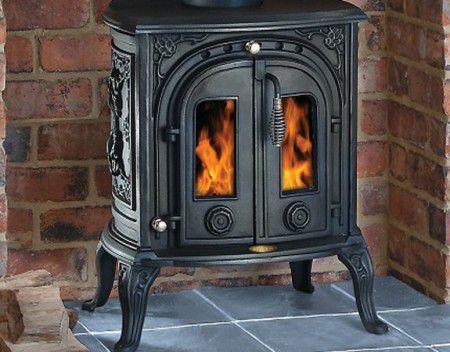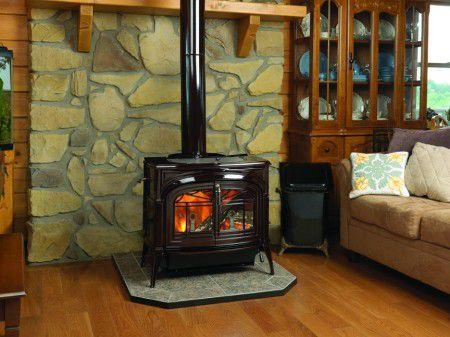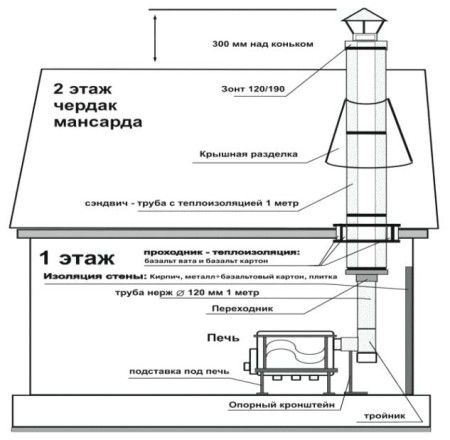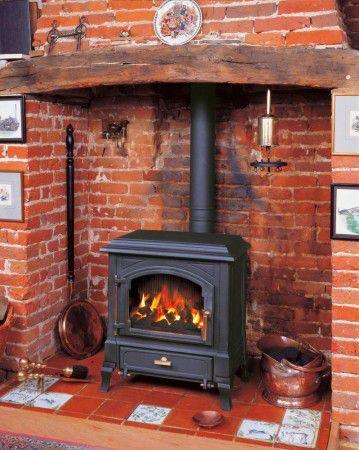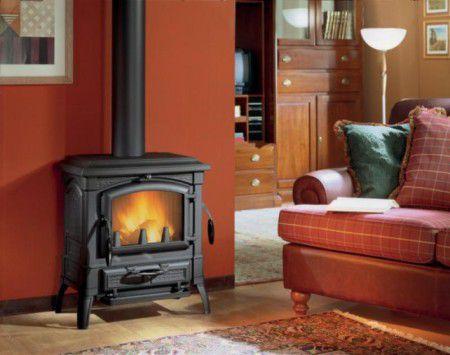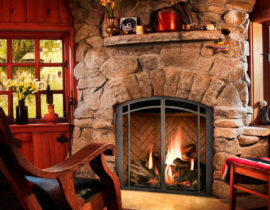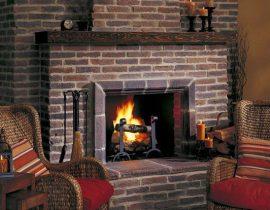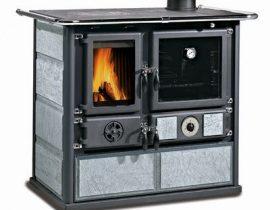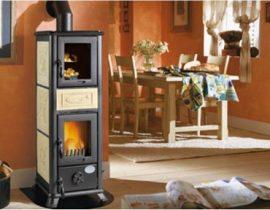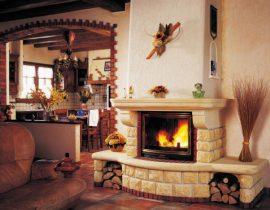Any summer resident dreams of a fireplace, where you can relax on a Saturday evening with a cup of aromatic tea. But not everyone can afford to build a real brick fireplace, because this is a serious load on the foundation and considerable costs, and laying fireplaces requires skill and knowledge. The way out of this situation is quite simple - cast iron fireplace stoves do not take up much space, and their installation is very simple and does not require major alterations of ceilings and walls.
Content
Features of the design of cast iron fireplaces
Cast iron fireplace for a summer residence, like its traditional predecessor brick, equipped with a firebox in which firewood or another type of fuel is burned, as well as a chimney. The firebox is made of cast iron, which increases its durability and heat resistance - a cast-iron fireplace can easily withstand temperature fluctuations from minus to high plus, while it does not lead away like steel stoves. Its front part is called a portal and is also made of cast iron or covered with fire-resistant facing materials.
A radiator-heat exchanger is built into the walls of the furnace, which allows to accumulate and give off heat.The firebox of some models is equipped with cast-iron doors with refractory glass, which ensures safety and metered air supply to the flame. Thanks to this, it becomes possible to implement a long burning mode, less firewood consumption and high efficiency. The glass is designed in such a way that, with proper installation of air flows, it is not subject to soot contamination.
Depending on the model, cast-iron fireplace stoves for summer cottages are also equipped with a cooking panel, it is located on its upper plane. Some models are also equipped with a firewood rack, an ash pan and other elements that increase the functionality of the fireplace stove.
The chimney for a fireplace stove is usually made of a special steel pipe with thermal insulation, it is not only resistant to the effects of combustion products, but also allows you to protect the ceiling structures and adjacent walls from fire.
Choosing a fireplace for a summer residence
The main characteristic necessary for the correct choice of a fireplace stove for a summer residence is its thermal power and the ability to heat a certain volume of the house. Usually the manufacturer indicates both parameters in the characteristics of the furnace. On average, the required power for a standard ceiling height is calculated as follows: 1 kW of thermal power is needed to heat 10 square meters of area, that is, for a house of 100 square meters, a stove with a capacity of 10 kW is enough.
The second important characteristic is the dimensions and weight of the furnace. Before buying, calculate the maximum dimensions that will provide fire-prevention distances to combustible structures of 25 cm, as well as the allowable load on the floors.For wooden floors, it is 150 kg per meter, for reinforced concrete - 800 kg per meter. If a cast iron cottage fireplace heavier, it is possible to strengthen the floor structure and redistribute the load over a larger area using the podium device for the furnace. It is made of sheets of thick plywood or chipboard with a mandatory finish with fire-resistant materials, such as tiles or sheet iron.
The third important factor is the type of fuel. It can be firewood, pellets, briquettes or biofuel - ethanol. Consider what kind of fuel is available in your area. If firewood is chosen as the main fuel, it is better to choose a model with a firewood rack, then you do not have to worry about where to store them.
The diameter of the chimney is important for the correct design of the pipe and penetrations through the floors. It is best to make careful measurements before buying and draw a plan of the room where the fireplace stove will be installed, as well as combined plans of all floors through which the pipe will pass. Also measure all vertical dimensions: the height of the ceiling on all floors, the thickness of the floors, the distance from the pipe to the ridge and the angle of the roof slope. All these parameters will be needed by specialists in order to correctly select the elements of the chimney.
Efficiency - an indicator of the efficiency of the furnace. Cast iron fireplace stoves for summer cottages with the function of long burning have an efficiency of up to 90%, which is a very high indicator. This efficiency is achieved due to the complete combustion of fuel without the emission of soot into the atmosphere. By choosing a fireplace stove with this function, you will not harm the environment and save yourself the need to clean the chimney.
Purchase and installation of a fireplace
- Prepare a floor plan, as well as all intermediate floors. It is also important to know the volume of heated rooms, the height of ceilings and roofs. With this information, go to the store and choose the model to your taste and budget. Immediately purchase all the recommended chimney parts for this stove, do not skimp on safety!
- The site for a cast-iron fireplace for a summer residence is prepared as follows: level the floor with a level and suitable non-combustible building materials, if necessary, reinforce the floors. If the wooden walls are too close to the sides of the fireplace, it is recommended to finish with tiles, artificial stone or install a thick foil screen. Non-flammable shields for furnaces are also on sale.
- Install the fireplace stove, setting it on the level. Holes are made in the ceilings in accordance with the plan and a chimney is installed, all penetrations are additionally insulated with basalt mats or slabs. The elements of the chimney are connected to each other using a heat-resistant sealant.
- Take the pipe to the roof. The height of the outer part of the pipe depends on its location relative to the ridge. The top of the pipe must be closed with a head, otherwise water, snow and traction may deteriorate.
- If necessary, finish the furnace portal with fire-resistant materials, not forgetting about air gaps for ventilation so that the furnace does not overheat. If the outer protective layer of paint was damaged during installation, it must be restored - the paint is sold in oven stores. It acquires its final strength after firing.
Proper operation of the oven
The service life of such a furnace depends on proper operation.Cast iron tolerates temperature changes without damage, and the thick walls of cast-iron fireplace stoves do not burn out for a long time. However, he is afraid of corrosion, so it is necessary to restore the protective layer of paint in a timely manner and protect the fireplace from excessive exposure to moisture.
It is also important not to overheat the fireplace stove and to prevent overheating of nearby wooden structures. If a cast-iron fireplace for a summer residence is equipped with glass, it can be left unattended for a long time, models with an open firebox require constant monitoring.
The ashpit, firebox and chimney must be promptly cleaned of combustion products: ash and soot. Otherwise, sooner or later, the traction will deteriorate, and gaps will occur. Most soot and soot are produced by raw firewood from coniferous trees, so try to find good birch firewood or pellets for your fireplace, and then your miracle stove will warm you and create a romantic mood for many years.
Video - cast iron fireplace at work


